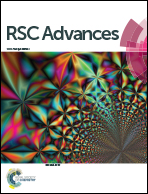A supercapacitor based on longitudinal unzipping of multi-walled carbon nanotubes for high temperature application†
Abstract
Multi-walled carbon nanotubes (MWCNTs) were partially unzipped longitudinally by a chemical method. Unzipped multi-walled carbon nanotubes (UZ-MWCNTs) were characterized by transmission electron microscopic analysis, X-ray diffraction and Raman spectroscopic analyses. UZ-MWCNTs were utilized for electrode preparation and the electrodes were used in the fabrication of a supercapacitor. At room temperature, the UZ-MWCNTs based supercapacitor showed a specific capacitance of ∼41 F g−1, while pristine MWCNTs based supercapacitor exhibited 22 F g−1 at the scan rate of 25 mV s−1. The increase in specific capacitance was attributed to an increase in effective specific surface area of UZ-MWCNTs due to partial unzipping. UZ-MWCNTs based supercapacitor exhibited an increase in specific capacitance with increase in temperature. It showed a specific capacitance of ∼74 F g−1 at 100 °C at the scan rate of 25 mV s−1, while the pristine MWCNTs based supercapacitor did not show any appreciable change in specific capacitance as a function of temperature. UZ-MWCNTs exhibited three-fold increase in specific capacitance as compared to pristine MWCNTs at 100 °C. Impedance spectroscopic analysis of the supercapacitors revealed that the UZ-MWCNTs based supercapacitor exhibited higher internal resistance and lower leakage resistance than pristine MWCNTs based supercapacitor. Continuous ‘charge–discharge’ cycling behaviour indicated that the UZ-MWCNTs based supercapacitor exhibited less stability during initial cycles even though it depicted higher specific capacitance as compared to the pristine MWCNTs based supercapacitor.


 Please wait while we load your content...
Please wait while we load your content...